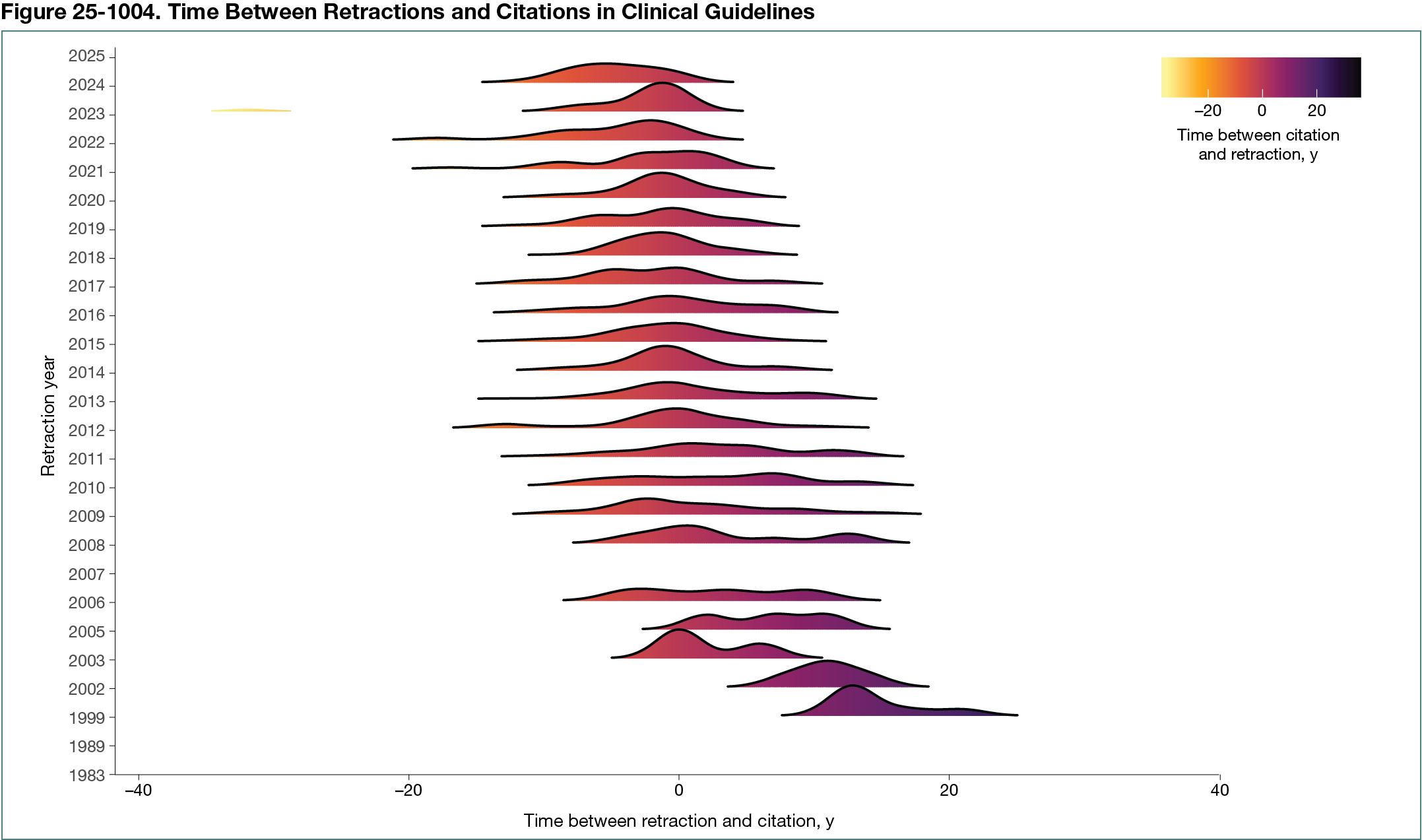Abstract
Retracted Publications Referenced in Clinical Guidelines
Lonni Besançon,1 Guillaume Cabanac,2,3 Kathryn Weber-Boer4
Objective
We identified retracted references in clinical guidelines published between 1991 and 2025 that were cited before and after retraction to study the scale of this contamination. Clinical guidelines have a concrete impact on the practice of medicine and, while active, are meant to reflect the state of the art. Previous work1 has explored the citation of retracted trials in systematic reviews and clinical guidelines, showing both pre- and postretraction citations. We explored a population of retracted publications cited in clinical guidelines.
Design
We drew on 2 new datasets: clinical guidelines from Altmetric (n = 20,553) and retractions identified by Dimensions (n = 63,047). The clinical guidelines dataset2 (articles indexed in Dimensions classified as clinical guidelines and documents published online by learned societies and associations) should consist of the latest version of each guideline, although as guidelines are updated, the guidelines that we studied may become obsolete. This dataset included links to guidelines and a list of publications referenced in each guideline. The retractions dataset was derived from CrossRef, PubMed, and Retraction Watch, and by matching publisher notices to publications; it included an identifier for the retracted publication and relevant linked notices with their type and date. We identified publications found both in the list of guideline references and in the list of retracted publications and selected those cited after their retraction date (398 unique guideline-retracted publication pairs). We manually examined a randomly selected 10% of the accessible English-language publications to assess the accuracy of the dataset (42 guideline-reference pairs). Our evaluation of this sample of our dataset assessed both whether the retraction identification was accurate and whether the citation of these publications in the guidelines was critical (or mentioned the retraction).
Results
We considered publications cited in the year of retraction to be preretraction citations. We found 487 guidelines containing 596 references to 319 publications that had been retracted after citation. Of these, 179 guidelines (37%) referenced 134 retracted publications 204 times within 5 years after retraction (Figure 25-1004).
There were 107 guidelines (22%) containing 126 references to 73 publications that had been retracted more than 5 years before citation. All retraction datasets, including ours, contained inaccuracies. We could not find retraction notices for 4 references marked as retracted. Only 2 retracted references were cited critically (presented with some doubt as to the strength of their methods or conclusions), and none acknowledged the retracted status of the reference. Most references were used either as background literature or to support claims and recommendations made in the guidelines.
Conclusions
Postretraction citations are preventable. The longer after the retraction appears, the more concerning the citation. In guidelines in particular, the persistence of retracted references is concerning. Our results highlight the need to systematically screen both new and existing clinical guidelines for contamination.
References
1. Kataoka Y, Banno M, Tsujimoto Y, et al. Retracted randomized controlled trials were cited and not corrected in systematic reviews and clinical practice guidelines. J Clin Epidemiol. 2022;150:90-97. doi:10.1016/j.jclinepi.2022.06.015
2. Altmetric. Clinical guidelines. Accessed June 19, 2025. https://www.altmetric.com/about-us/our-data/clinical-guidelines/
1Linköping University, Linköping, Sweden; 2Université de Toulouse, Institut de Recherche en Informatique de Toulouse (UMR 5505), Centre National de la Recherche Scientifique, Toulouse, France; 3Institut Universitaire de France, Paris, France; 4Digital Science, London, UK, k.weberboer@digital-science.com.
Conflict of Interest Disclosures
Kathryn Weber-Boer is employed by Digital Science, which provided access to the Altmetric and Dimensions datasets that this work analyzed. Lonni Besançon has received a catalyst grant from Digital Science. No other disclosures were reported.

